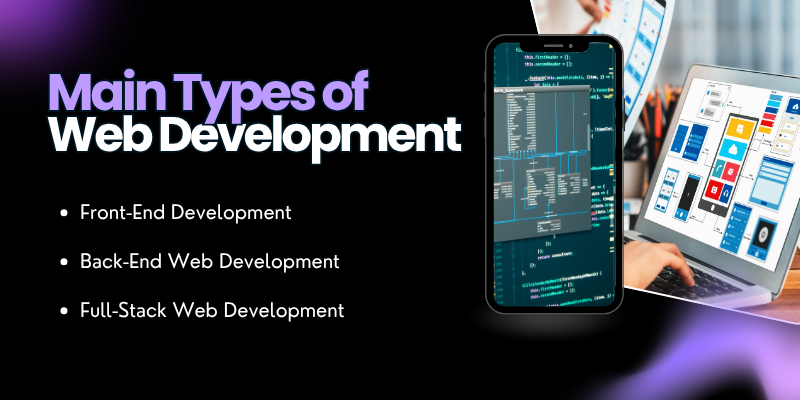Still curious about exactly what is web development?
In simple terms, web development is the process of creating and maintaining websites and web applications.
From designing the user interface (UI) to programming the server-side logic that makes everything work, web development covers it all.
It’s divided into two main areas: front-end (client-side) and back-end (server-side) development. The front-end is all about creating a seamless, visually appealing user experience, while the back-end handles the data and
As more users rely on the internet for information, shopping, and communication, having a well-designed, user-friendly website or web application is critical.
Whether it’s an e-commerce site, a corporate blog, or a social media platform, web development is at the heart of all digital interactions.
This blog explores the key aspects of web development, from programming languages and design principles to the latest trends, and highlights its critical role in helping businesses thrive in the digital era.
What is Web Development?
Web development is the process of designing, building, and maintaining websites and web applications. It combines technical expertise with creative problem-solving to create functional and visually appealing online experiences. As a part of web development, SEO audit tools are often used to evaluate and improve a website’s search engine optimization, ensuring it performs well in search rankings.

Key aspects of web development include:
- Designing responsive websites and user interfaces that adapt seamlessly to different devices
- Developing interactive features like forms and login systems that work efficiently across various browsers
- Managing databases to store user data and content securely
- Implementing security protocols to protect websites and applications from cyber threats
- Optimizing websites for speed, performance, and search engine visibility (SEO) using SEO ranking report software to track and enhance website performance and rankings.
Web Development vs Web Design
Here’s a comparison table to differentiate between Web Development and Web Design:
|
Aspect |
Web Development |
Web Design |
|
Definition |
The process of building and maintaining websites and web applications, focusing on functionality and interactivity. |
The process of designing the layout, look, and feel of a website or web application, focusing on aesthetics and user experience. |
|
Main Focus |
Coding and programming for the website's functionality. |
Visual design, layout, and user interface (UI) design. |
|
Skills Required |
HTML, CSS, JavaScript, PHP, Python, SQL, and other programming languages. |
Graphic design, typography, color theory, layout design, and UI/UX design principles. |
|
Tools Used |
Text editors, IDEs, version control systems (Git), frameworks (React, Angular), databases (MySQL, MongoDB). |
Design software like Adobe XD, Figma, Sketch, and wireframing tools. |
|
Responsibilities |
Building and coding the website's structure, functionality, and interactivity. |
Creating the visual appearance, structure, and user experience of the website. |
|
End Goal |
Ensuring the website works as intended, is interactive, and can handle data. |
Creating a visually appealing and user-friendly interface. |
|
Languages Used |
HTML, CSS, JavaScript, PHP, Ruby, Python, Node.js, SQL, etc. |
Primarily HTML and CSS for design layout, but mostly focuses on visual aesthetics. |
|
Involves |
Back-end development (server-side), front-end development (client-side), database management, and security measures. |
Wireframes, mockups, branding, typography, and color schemes. |
|
Outcome |
Functional website or web app that performs all necessary tasks and interactions. |
Visually engaging and easy-to-navigate user interface. |
|
Collaboration |
Often collaborates with designers to bring the visual design to life. |
Works closely with developers to ensure the design is implemented correctly. |
3 Main Types of Web Development
Types of Web Development include front-end development, which focuses on the user interface, back-end development for server-side logic, and full-stack development that combines both.

There are three main types of web development:
1. Front-End Web Development
Front end development focuses on the user-facing side of a website or application. It involves building the layout, design, structure, and interactivity that users directly interact with.
Technologies like HTML, CSS, and JavaScript are commonly used to create engaging and responsive user interfaces.
2. Back-End Web Development
Back-end development is concerned with the server-side of a website or application. It involves working with databases, servers, and application logic to ensure that the website functions smoothly.
Languages like Python, Ruby, PHP, and Java, along with database management systems like MySQL and MongoDB, are used to handle the behind-the-scenes processes that support the front end.
3. Full-Stack Web Development
Full stack development combines both front-end and back-end web development. Full-stack developers are skilled in both aspects of web development, allowing them to build and maintain entire web applications.
They are proficient in both client-side and server-side technologies, making them versatile developers capable of handling all layers of a web project.
Other 4 types of web development
Besides front-end, back-end, and full-stack development, you can specialize in:
- Mobile development: Creating websites and apps for phones and tablets.
- Game development: Building browser-based games with JavaScript and HTML5.
- E-commerce development: Building online stores with payment systems and shopping carts.
- CMS development: Creating websites using content management systems (CMSs) like WordPress or Drupal.
Explore Our Web Design & Development Services!
Web Development Process: 4 Steps You Must Follow
The web development process is a series of stages involved in creating a website or web application, from initial planning to final deployment.
It requires collaboration between web developers, designers, and stakeholders to ensure the project meets functional, aesthetic, and performance requirements.

The process typically follows a structured approach to ensure each step is completed efficiently and effectively.
1. Planning and Design
This initial phase involves understanding project requirements, defining goals, and creating wireframes or mockups. It sets the foundation for a user-friendly and visually appealing website or application.
2. Development and Coding
In this phase, developers write the actual code for the website or application. Front-end developers focus on the user interface, while back-end developers handle server-side logic and database integration.
3. Testing and Debugging
After development, the website undergoes thorough testing to identify and fix bugs, ensure functionality, and optimize performance across different devices and browsers.
4. Deployment and Maintenance
Once testing is complete, the website is deployed to a live server. Ongoing maintenance includes updates, security monitoring, performance optimization, and adding new features as needed to keep the website running smoothly.
Why Web Development is Important for Businesses
Web development plays a pivotal role in building a strong online presence, which is essential for attracting and engaging customers in today’s digital world.
A well-developed website or web application serves as the cornerstone of a business’s online identity, providing a platform for showcasing products, services, and brand values.
By having a professional, user-friendly website, businesses can reach a global audience, expanding their reach far beyond local boundaries.
Effective web development allows businesses to scale, offering seamless customer experiences across different devices and platforms, while enabling them to tap into new markets, drive sales, and ultimately fuel growth.
Web Development Skills to Consider When Hiring a Web Development Agency
When hiring a web development agency, it's important to ensure they possess the necessary skills to deliver a website that meets your business needs, is user-friendly, and performs well across all devices. The agency should also have experience with B2B Website Development to ensure that their solutions cater to the unique requirements of business-to-business interactions and corporate environments.
The right agency will have a team of developers with expertise in the latest web technologies and best practices.
Here are the key web development skills to look for:
- Proficiency in Front-End and Back-End Development: A good web development agency should have expertise in both front-end (HTML, CSS, JavaScript) and back-end (Node.js, PHP, Python) technologies to create a fully functional and dynamic website.
- Responsive Design Expertise: Look for an agency that ensures your website will look and work great on all devices, from desktops to mobile phones, by implementing responsive web design techniques.
- Experience with Frameworks and Libraries: An agency that is familiar with popular frameworks and libraries, such as React, Angular, or Laravel, will be able to build scalable, efficient, and high-performing websites.
- SEO and Performance Optimization: It’s crucial to hire an agency that understands the importance of search engine optimization (SEO) and web performance. They should know how to optimize your site for faster loading times and better search engine rankings.
- Security Awareness: Security should be a top priority. The agency should have experience with implementing security measures like SSL certificates, data encryption, and secure authentication processes to keep your website safe from vulnerabilities.
Future Trends in Web Development
Future Trends in Web Development include Progressive Web Apps (PWAs), responsive design, and SharePoint consulting services to improve collaboration and data management on websites and applications. These services are especially useful for businesses using Microsoft tools to create intranet sites, content management systems, and online document libraries.

Here are the key future trends in web development:
1. AI-Powered Development Tools
Artificial Intelligence is revolutionizing web development by automating tasks, enhancing personalization, and optimizing workflows.
Tools like GitHub Copilot and OpenAI's Codex assist developers by generating code snippets, suggesting improvements, and automating repetitive tasks, thereby accelerating development processes and reducing errors.
2. Progressive Web Apps (PWAs)
PWAs combine the best features of web and mobile applications, offering offline capabilities, push notifications, and fast load times.
They provide a seamless user experience across devices and are increasingly adopted to enhance engagement and performance.
3. WebAssembly (Wasm)
WebAssembly enables high-performance execution of code in web browsers, allowing applications traditionally built for desktop environments to run efficiently on the web.
This technology is particularly beneficial for applications requiring intensive computations, such as gaming, video editing, and scientific simulations.
4. Serverless Architecture
Serverless computing allows developers to build and run applications without managing server infrastructure. This approach reduces overhead, enhances scalability, and allows for more efficient resource utilization, making it an attractive option for modern web applications.
5. Enhanced Cybersecurity Measures
With the increasing prevalence of cyber threats, robust security practices are paramount. Web developers are implementing advanced security protocols, such as multi-factor authentication, data encryption, and secure coding practices, to protect user data and maintain trust.
Conclusion
Now that you have a better understanding of what is web development, it's clear that it plays a crucial role in today’s digital landscape. Web development is key for building dynamic, interactive, and user-friendly websites and applications that drive business growth. Companies like Centric, a leading digital transformation agency, specialize in delivering cutting-edge web solutions that elevate brand presence. Also, it forms the foundation of a strong online presence, enabling companies to reach a global audience, enhance user experiences, and stay competitive. By embracing the latest trends and technologies in web development, businesses can ensure ongoing digital success and thrive in an ever-changing market.








